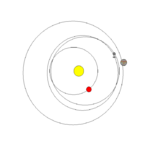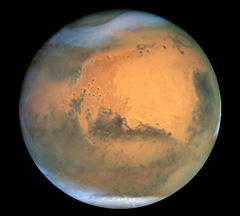Moons of Mars


Mars has two tiny moons, Phobos and Deimos, which are thought to be captured asteroids.
If viewed from the surface of Mars near its equator, full Phobos looks about one third as big as the Earth's full moon from Earth. It has an angular diameter of between 8' (rising) and 12' (overhead). It would look smaller when the observer is further away from the Martian equator, and is completely invisible (always beyond the horizon) from Mars' polar ice caps. Deimos looks more like a bright star or planet for an observer on Mars, only slightly bigger than Venus looks from earth; it has an angular diameter of about 2'. The Sun's angular diameter as seen from Mars, by contrast, is about 21'. Thus there are no total solar eclipses on Mars, as the moons are far too small to completely cover the Sun. On the other hand, total lunar eclipses of Phobos are very common, happening almost every night. See also Transit of Phobos from Mars and Transit of Deimos from Mars for eclipse-like events.
The motions of Phobos and Deimos would appear very different from that of our own Moon. Speedy Phobos rises in the west, sets in the east, and rises again in just eleven hours, while Deimos, being only just outside synchronous orbit, rises as expected in the east but very slowly. Despite its 30 hour orbit, it takes 2.7 days to set in the west as it slowly falls behind the rotation of Mars, and has long again to rise.
Both moons are tidally locked, always presenting the same face towards Mars. Since Phobos orbits Mars faster than the planet itself rotates, tidal forces are slowly but steadily decreasing its orbital radius. At some point in the future, when it approaches Mars closely enough (see Roche limit), Phobos will be broken up by these tidal forces. Several strings of craters on the Martian surface, inclined further from the equator the older they are, suggest that there may have been other small moons that suffered the fate expected of Phobos, and also that the Martian crust as a whole shifted between these events. Deimos, on the other hand, is far enough away that its orbit is being slowly boosted instead, as in the case of our own Moon.
Both satellites were discovered in 1877 by Asaph Hall, and are named after the characters Phobos (panic/fear) and Deimos (terror/dread) who, in Greek mythology, accompanied their father Ares, god of war, into battle. Ares was known as Mars to the Romans.
Searches have been conducted for additional satellites. Most recently, Scott S. Sheppard and David C. Jewitt surveyed the Hill sphere of Mars for irregular satellites. [The] search covered nearly the entire Hill sphere, but scattered light from Mars excluded the inner few arcminutes where the satellites Phobos and Deimos reside. No new satellites were found to an apparent limiting red magnitude of 23.5, which corresponds to radii of about 0.09 km using an albedo of 0.07. [1]
Orbital details
| Name and pronunciation | Image | Diameter (km) | Mass (kg) | Semi-major axis (km) |
Orbital period (h) |
Average moonrise period (h, d) |
||
|---|---|---|---|---|---|---|---|---|
| Mars I | Phobos | /ˈfoʊbəs/ FOE-bəs |
|
22.2 km (27×21.6×18.8) | 1.08×1016 | 9 377 km | 7.66 | 11.12 h (0.463 d) |
| Mars II | Deimos | /ˈdaɪməs/ DYE-məs |
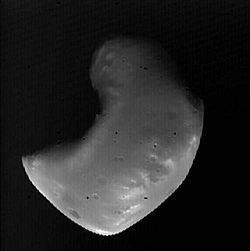 |
12.6 km (10×12×16) | 2×1015 | 23 460 km | 30.35 | 131 h (5.44 d) |
Discovery
The discovery of the two moons of Mars, Phobos and Deimos, occurred in 1877 when American astronomer Asaph Hall, Sr. identified them after a long search, although their existence had been speculated before.
Early speculations
The possibility of Martian moons had been speculated before Hall's discovery. The astronomer Johannes Kepler (1571-1630) even predicted their number correctly, although with faulty logic: he wrote that since Jupiter had four known moons and Earth had one, it was only natural that Mars should have two.[2]
Perhaps inspired by Kepler, Jonathan Swift's novel Gulliver's Travels (1726) refers to two moons in part 3, chapter 3 (the "Voyage to Laputa"), in which the astronomers of Laputa are described as having discovered two satellites of Mars orbiting at distances of 3 and 5 Martian diameters, and periods of 10 and 21.5 hours, respectively. This corresponds to the actual orbital distances and periods of Phobos and Deimos of 1.4 and 3.5 Martian diameters, and 7.6 and 30.3 hours, respectively. Swift's prediction is regarded as a coincidence since no telescope in Swift's day was powerful enough to discover the satellites.[2]
Voltaire's 1750 novel Micromégas, about an alien visitor to Earth, also refers to two moons of Mars. Voltaire was presumably influenced by Swift.[3]
Discovery
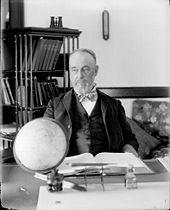
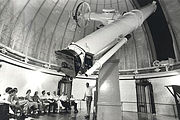
Hall discovered Deimos on August 12, 1877 at about 07:48 UTC and Phobos on August 18, 1877, at the US Naval Observatory in Washington, D.C., at about 09:14 GMT (contemporary sources, using the pre-1925 astronomical convention that began the day at noon, give the time of discovery as August 11, 14:40 and August 17 16:06 Washington mean time respectively).[4][5][6] At the time, he was deliberately searching for Martian moons. Hall had previously seen what appeared to be a Martian moon on August 10, but due to bad weather, he could not definitively identify them until later.
Hall recorded his discovery of Phobos in his notebook as follows:[7]
- I repeated the examination in the early part of the night of [August] 11th, and again found nothing, but trying again some hours later I found a faint object on the following side and a little north of the planet. I had barely time to secure an observation of its position when fog from the River stopped the work. This was at half past two o'clock on the night of the 11th. Cloudy weather intervened for several days.
- On 15 August the weather looking more promising, I slept at the Observatory. The sky cleared off with a thunderstorm at 11 o'clock and the search was resumed. The atmosphere however was in a very bad condition and Mars was so blazing and unsteady that nothing could be seen of the object, which we now know was at that time so near the planet as to be invisible.
- On August 16 the object was found again on the following side of the planet, and the observations of that night showed that it was moving with the planet, and if a satellite, was near one of its elongations. Until this time I had said nothing to anyone at the Observatory of my search for a satellite of Mars, but on leaving the observatory after these observations of the 16th, at about three o'clock in the morning, I told my assistant, George Anderson, to whom I had shown the object, that I thought I had discovered a satellite of Mars. I told him also to keep quiet as I did not wish anything said until the matter was beyond doubt. He said nothing, but the thing was too good to keep and I let it out myself. On 17 August between one and two o'clock, while I was reducing my observations, Professor Newcomb came into my room to eat his lunch and I showed him my measures of the faint object near Mars which proved that it was moving with the planet.
- On August 17 while waiting and watching for the outer moon, the inner one was discovered. The observations of the 17th and 18th put beyond doubt the character of these objects and the discovery was publicly announced by Admiral Rodgers.
The names, originally spelled Phobus and Deimus, respectively, were suggested by Henry Madan (1838–1901), Science Master of Eton, from Book XV of the Iliad, where Ares summons Fear and Fright.[8]
Jonathan Swift and the moons of Mars
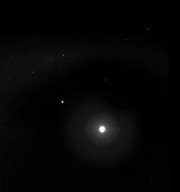
The existence of two fictional Martian moons was described in Jonathan Swift's satirical novel Gulliver's Travels, published in 1726, 150 years before their discovery:
- They [the Laputan astronomers] have likewise discovered two lesser stars, or 'satellites', which revolve about Mars, whereof the innermost is distant from the centre of the primary planet exactly three of his diameters, and the outermost five; the former revolves in the space of ten hours, and the latter in twenty-one and a half; so that the squares of their periodical times are very near in the same proportion with the cubes of their distance from the centre of Mars, which evidently shows them to be governed by the same law of gravitation, that influences the other heavenly bodies...
Phobos and Deimos are in fact about 1.4 and 3.5 diameters from Mars' centre, and their periods are 7.7 and 30.3 hours, respectively. A similar discovery was described by Voltaire in his interplanetary romance Micromegas, published in 1752.
In recognition of these 'predictions', two craters on Deimos are named Swift and Voltaire.
See also
- Phobos and Deimos in fiction
- Natural satellites of Jupiter · Saturn · Uranus · Neptune · Pluto
- Timeline of discovery of Solar System planets and their natural satellites
- Naming of natural satellites
References
- ↑ Astron. J., 128, 2542-2546 (2004)
- ↑ 2.0 2.1 MathPages - Galileo's Anagrams and the Moons of Mars.
- ↑ William Sheehan, The Planet Mars: A History of Observation and Discovery
- ↑ "Notes: The Satellites of Mars" 181–185. The Observatory, Vol. 1, No. 6 (September 20, 1877). Retrieved on September 12, 2006.
- ↑ Hall, A. (October 17, 1877, signed September 21, 1877). "Observations of the Satellites of Mars" pp. 11/12–13/14. Astronomische Nachrichten, Vol. 91, No. 2161. Retrieved on September 12, 2006.
- ↑ Morley, T. A.; A Catalogue of Ground-Based Astrometric Observations of the Martian Satellites, 1877-1982, Astronomy and Astrophysics Supplement Series (ISSN 0365-0138), Vol. 77, No. 2 (February 1989), pp. 209–226 (Table II, p. 220: first observation of Phobos on 1877-08-18.38498)
- ↑ "The Discovery of the Satellites of Mars" pp. 205-209. Monthly Notices of the Royal Astronomical Society, Vol. 38, No. 4 (February 8, 1878). Retrieved on September 12, 2006.
- ↑ Hall, A. (March 14, 1878, signed February 7, 1878). "Names of the Satellites of Mars" 47-48. Astronomische Nachrichten, Vol. 92, No. 2187. Retrieved on September 12, 2006.
|
||||||||||||||||||||||||||||||||||||||||||||
|
|||||||||||||||||
|
|||||||||||||||||
